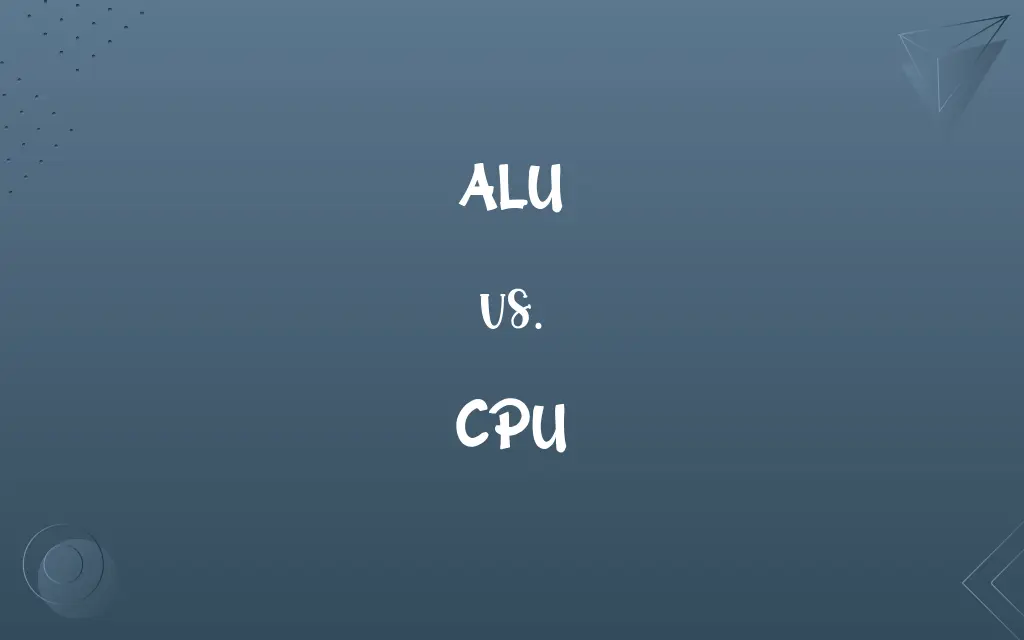ALU vs. CPU: Know the Difference

By Shumaila Saeed || Updated on December 25, 2023
The ALU (Arithmetic Logic Unit) performs arithmetic and logical operations in a computer, while the CPU (Central Processing Unit) is the primary component executing instructions and coordinating system functions.

Key Differences
The ALU is a critical component within the CPU, responsible for executing arithmetic and logical operations, including addition, subtraction, and comparison. The CPU, encompassing the ALU, is the brain of the computer, interpreting and executing instructions from software and hardware.
Shumaila Saeed
Nov 22, 2023
The ALU is a relatively simpler subsystem focused solely on specific computational tasks. In contrast, the CPU is a complex unit, integrating the ALU and other components like the control unit and cache, orchestrating the entire computing process.
Shumaila Saeed
Nov 22, 2023
The ALU directly handles the basic mathematical and logical data processing operations. The CPU, utilizing the ALU, makes decisions, controls execution flow, and processes complex computations.
Shumaila Saeed
Nov 22, 2023
In the hierarchy of computer architecture, the ALU operates as a subordinate element within the CPU. The CPU stands at the top of this hierarchy, managing not only the ALU but also interacting with memory, input/output systems, and other computer components.
Shumaila Saeed
Nov 22, 2023
Over time, the ALU has evolved to become faster and more efficient in performing its tasks. The CPU has simultaneously advanced, incorporating more sophisticated ALUs, enhancing processing speed, and adapting to emerging computational demands.
Shumaila Saeed
Nov 22, 2023
ADVERTISEMENT
Comparison Chart
Primary Function
Performs arithmetic and logical operations
Executes instructions, coordinates system functions
Shumaila Saeed
Nov 22, 2023
Complexity
Relatively simple, focused component
Complex unit with multiple components
Shumaila Saeed
Nov 22, 2023
Role in Data Processing
Direct data processing
Decision making, overall process management
Shumaila Saeed
Nov 22, 2023
Position in Architecture
Subsystem within CPU
Central component in computing architecture
Shumaila Saeed
Nov 22, 2023
Evolution
Improved speed and efficiency
Advanced with sophisticated ALUs, faster processing
Shumaila Saeed
Nov 22, 2023
ADVERTISEMENT
ALU and CPU Definitions
ALU
The ALU performs basic arithmetic calculations in a computer.
The ALU in my computer's processor quickly calculates complex equations.
Shumaila Saeed
Nov 18, 2023
CPU
CPU coordinates all activities within the computer system.
The CPU acts as the brain of my laptop, managing all tasks.
Shumaila Saeed
Nov 18, 2023
ALU
ALU is responsible for logical operations like AND, OR, NOT.
Logical decision-making in programming is handled by the ALU.
Shumaila Saeed
Nov 18, 2023
CPU
Modern CPUs contain multiple cores for efficient multitasking.
My quad-core CPU handles multiple applications seamlessly.
Shumaila Saeed
Nov 18, 2023
ALU
ALU operations are fundamental to computer programming.
Every command in a program eventually passes through the ALU.
Shumaila Saeed
Nov 18, 2023
ADVERTISEMENT
CPU
CPU's performance is key to the overall speed of a computer.
Upgrading the CPU significantly improved my computer's performance.
Shumaila Saeed
Nov 18, 2023
ALU
The ALU is an essential part of the computer's CPU.
The efficiency of a CPU greatly depends on the performance of its ALU.
Shumaila Saeed
Nov 18, 2023
CPU
The CPU is the central unit that processes computer instructions.
The speed of my computer is largely determined by its CPU.
Shumaila Saeed
Nov 18, 2023
ALU
The ALU handles the mathematical aspects of computing.
Complex graphics rendering is facilitated by the ALU's calculations.
Shumaila Saeed
Nov 18, 2023
CPU
The CPU integrates the ALU for arithmetic and logical tasks.
The CPU's ALU component is crucial for its computing capabilities.
Shumaila Saeed
Nov 18, 2023
CPU
The central processing unit, that part of the electronic circuitry of a computer in which the arithmetic and logical operations are performed on input data, which are thereby converted to output data; it is usually located on the mainboard, or motherboard, of a computer. The CPU and the memory form the central part of a computer to which the peripherals are attached. Most personal computers as of 1998 had only one CPU, but some computers may have more than one CPU.
Shumaila Saeed
Nov 17, 2023
CPU
(computer science) the part of a computer (a microprocessor chip) that does most of the data processing; the CPU and the memory form the central part of a computer to which the peripherals are attached
Shumaila Saeed
Nov 17, 2023
Repeatedly Asked Queries
What does CPU stand for?
CPU stands for Central Processing Unit, the primary component of a computer that executes instructions.
Shumaila Saeed
Nov 22, 2023
How does the ALU relate to the CPU?
The ALU is a part of the CPU responsible for handling all arithmetic and logical operations.
Shumaila Saeed
Nov 22, 2023
What operations does the ALU perform?
The ALU performs basic arithmetic (like addition, subtraction) and logical operations (like AND, OR).
Shumaila Saeed
Nov 22, 2023
Can a CPU function without an ALU?
No, the CPU relies on the ALU for essential arithmetic and logical data processing tasks.
Shumaila Saeed
Nov 22, 2023
Can the CPU's performance be enhanced by the ALU?
Yes, a more efficient ALU can enhance the overall performance of the CPU.
Shumaila Saeed
Nov 22, 2023
Is the CPU responsible for processing data?
Yes, the CPU processes data by executing instructions and coordinating tasks within the computer.
Shumaila Saeed
Nov 22, 2023
What is an ALU?
ALU stands for Arithmetic Logic Unit, a component in CPUs that performs arithmetic and logical operations.
Shumaila Saeed
Nov 22, 2023
Do all computers have an ALU?
Yes, all CPUs in computers have an ALU as it's essential for processing data.
Shumaila Saeed
Nov 22, 2023
Does the CPU store data?
The CPU processes data but typically does not store it; storage is handled by memory units.
Shumaila Saeed
Nov 22, 2023
Are ALUs present in all types of CPUs?
Yes, ALUs are a standard component in all types of CPUs, regardless of the device or model.
Shumaila Saeed
Nov 22, 2023
How does the CPU interact with the computer's memory?
The CPU retrieves and sends instructions and data to and from the computer's memory.
Shumaila Saeed
Nov 22, 2023
What's the role of the CPU in a computer?
The CPU acts as the brain of the computer, executing programs and managing system operations.
Shumaila Saeed
Nov 22, 2023
What determines a CPU's processing power?
A CPU's processing power is determined by factors like clock speed, core count, and ALU efficiency.
Shumaila Saeed
Nov 22, 2023
Is the CPU involved in running software?
Yes, the CPU is crucial in running software by executing the program's instructions.
Shumaila Saeed
Nov 22, 2023
Can the ALU be upgraded separately from the CPU?
Typically, the ALU cannot be upgraded separately as it is an integral part of the CPU.
Shumaila Saeed
Nov 22, 2023
Are ALU and CPU the same thing?
No, the ALU is a component within the CPU that specifically handles arithmetic and logic operations.
Shumaila Saeed
Nov 22, 2023
What kind of logical operations does an ALU perform?
An ALU performs logical operations like comparing numbers and determining truth values.
Shumaila Saeed
Nov 22, 2023
How does the ALU affect computing speed?
The efficiency of the ALU directly impacts the speed at which the CPU processes data.
Shumaila Saeed
Nov 22, 2023
Does the CPU manage external devices?
Yes, the CPU communicates with external devices, managing input/output operations.
Shumaila Saeed
Nov 22, 2023
Is the ALU responsible for graphics processing?
No, graphics processing is typically handled by the GPU (Graphics Processing Unit), not the ALU.
Shumaila Saeed
Nov 22, 2023
Share this page
Link for your blog / website
HTML
Link to share via messenger
About Author
Written by
Shumaila SaeedShumaila Saeed, an expert content creator with 6 years of experience, specializes in distilling complex topics into easily digestible comparisons, shining a light on the nuances that both inform and educate readers with clarity and accuracy.







































































